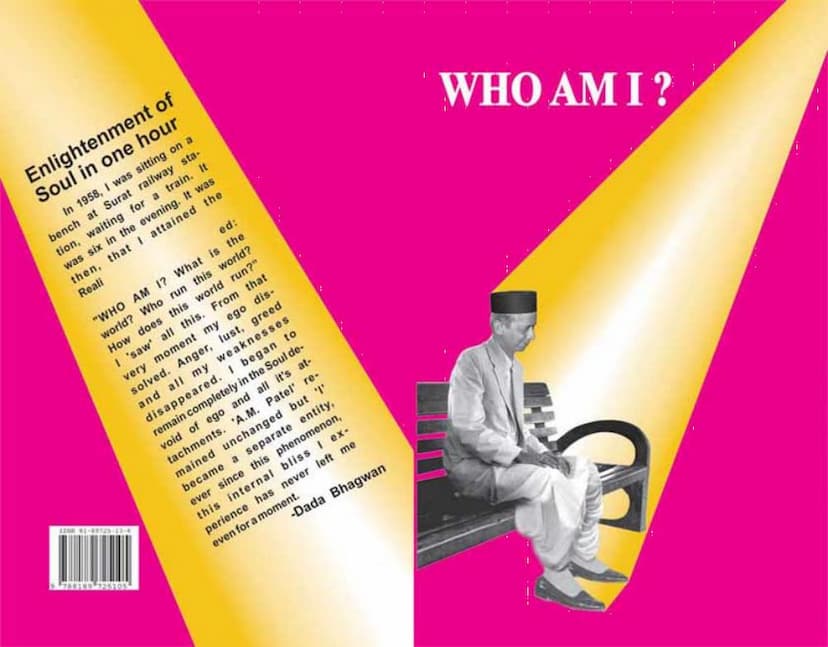Who Am I
Added to library: September 2, 2025

Summary
This document is a summary of the Jain text "Who Am I" by Dada Bhagwan, published by the Dada Bhagwan Foundation. It outlines a direct, step-less path to spiritual liberation known as Akram Vignan.
Core Teachings and Concepts:
- The Question "Who Am I?": The book posits that the ultimate purpose of life is to find the answer to this fundamental question, which has remained unanswered through infinite previous lives.
- Self-Realization in One Hour: The text describes Dada Bhagwan's own experience of spontaneous Self-realization at a railway station in 1958, where his ego dissolved, leading to the disappearance of anger, lust, greed, and weaknesses. He experienced internal bliss, becoming a "living instrument of The Lord."
- Dada Bhagwan: Dada Bhagwan is explained not as the physical form (A.M. Patel) but as the Pure Soul, the Lord manifested within. This Lord exists in everyone, but is fully manifest in the Gnani Purush.
- Akram Vignan (The Step-less Science): This is presented as a direct and easy path to liberation, akin to an elevator. It contrasts with the traditional "Kramic" path, which is described as step-by-step, arduous, and requiring immense penance and time. Akram Vignan offers a shortcut.
- The Gnani Purush: A Gnani Purush is defined as a fully Self-Realized being, devoid of ego. They are essential for imparting the knowledge of the Self (Atmagnan) and can dissolve a seeker's ego. The book stresses the rarity of Gnani Purush and the necessity of meeting one for true Self-realization.
- Separating "I" and "My": A central theme is the process of distinguishing the true Self ("I") from everything that is "mine" (my body, mind, possessions, relationships, etc.). This separation is considered key to liberation. The Gnani provides a "separator" for this purpose.
- Wrong Beliefs (Mithyatva): The text identifies deeply ingrained wrong beliefs, such as "I am Chandulal" (a name used as an example), "I am a husband," "I am a father," etc., as the root cause of suffering and bondage. The goal is to replace these with the "right belief" of being the Pure Self.
- "Doership" and Scientific Circumstantial Evidence (Vyavasthit Shakti): The book explains that no one is the independent "doer" of actions. Events unfold due to a precise scientific law of cause and effect. Attributing doership to oneself creates new karma. God is not the creator of this world but resides within every being, giving them the light to act as they choose.
- Moksha (Liberation): Moksha is defined as coming to one's Real nature and experiencing eternal bliss. It is attainable in this lifetime (jeevanmukti) through Akram Vignan, not just after death. The first stage of Moksha involves experiencing neutrality towards worldly happiness and unhappiness.
- The Five Aagnas: These are five core principles or instructions given by the Gnani Purush to protect the seeker and ensure their progress on the path of liberation. Following these aagnas is presented as the current religion and penance.
- Simandhar Swami: The text highlights the importance of worshipping Shri Simandhar Swami, the present Tirthankar residing in Mahavideh Kshetra, as the true Arihant for this era. Praying with Dada Bhagwan as a witness is recommended for enhanced results.
- The Importance of the Gnani's Presence: While the Akram path continues through generations of Gnanis, the immediate presence of a living Gnani Purush is crucial for the direct impartation of Self-knowledge.
Overall Message:
"Who Am I" offers a practical and scientific approach to spiritual liberation, emphasizing that true understanding and freedom can be attained in a short period by connecting with a living Gnani Purush. The teachings aim to dismantle the ego and the illusion of individual doership, leading to the experience of the Pure Self and ultimate freedom from suffering. The book provides prayers and practices, like the Trimantra and the five Aagnas, to support the seeker on this path.